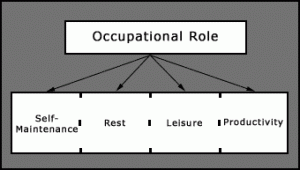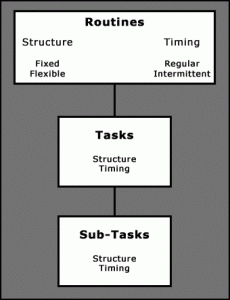CONSTRUCT 3: OCCUPATIONAL PERFORMANCE AREAS
Occupational therapy has traditionally categorised performance of daily occupations to three areas: self-maintenance occupations, productivity/school occupations and leisure/play occupations. This model proposes a fourth area: rest occupations. Others have also recognised its importance as a dimension of occupational performance (Llorens, 1991) (Fig. 3).
Rest Occupations refer to the purposeful pursuit of non-activity. This can include time devoted to sleep (Meyer, 1922/1977), as well as routines, tasks, subtasks and rituals undertaken in order to relax.
Inclusion of this category as separate from selfmaintenance occupations acknowledges that there are sociocultural, daily and life span reasons for the degree to which people are, or wish to be, passive and contemplative rather than active and productive (Rowles, 1991). For example, people who are growing older may have an increasing desire and ability for reminiscence, life review and more reflective modes of occupation (Coleman, 1986; Rowles, 1991).
Self-Maintenance Occupations are routines, tasks and subtasks done to preserve a person’s health and well-being in the environment (Reed 1984, p.499) Occupational Performance Model (Australia) 7 These routines, tasks and sub-tasks can be in the form of habitual routines (dressing, eating) or occasional nonhabitual tasks (taking medication) that are demanded by circumstance.
Productivity/School Occupations are routines, tasks and subtasks that are done to enable a person to provide support for self, family or community through the production of goods or provision of services (Reed, 1984, p.499).
Leisure/Play Occupations are those routines, tasks and subtasks that are done for purposes of entertainment, creativity and celebration.
Figure 3: Occupational Performance Areas and their relationship to other constructs in the Occupational Performance Model.
Occupations: Subtasks, Tasks & Routines
Although activity has been a term traditionally used in occupational therapy to denote purposefulness of action (Christiansen, 1991; Cynkin, 1979; Fidler & Fidler, 1978; Meyer, 1922/1977; Mosey, 1981). Meanings attributed to the underlying construct have become so broad and flexible that it has lost its power to 1) describe elements of occupations and performance at varying levels, and 2) to direct and influence the focus of occupational therapy intervention (Christiansen, 1991; Jenkins, 1993; Lyons, 1983; Nelson, 1988). At this point in the development of the Occupational Performance Model (Australia) occupations in each occupational performance area have been classified according to the existing complexity of structure and time (Fig. 4).
Figure 4: Structure of Occupations in the Occupational Performance Model: Routines, Tasks and Subtasks.
First, the structure of an occupation can be viewed from three levels of complexity: subtasks, tasks and routines. Subtasks consist of steps or single units of the total task and are stated in terms of observable behaviour (Romiszowski, 1984). Tasks are viewed as sequences of subtasks that are ordered from the first performed to the last performed to accomplish a specific purpose. These tasks can be carried out in action or thought (planned or imagined). For example, drinking can be divided into subtasks such as locating the glass, reaching for the glass, grasping the glass and lifting the glass. All of these subtasks, when put together in an orderly sequence, result in execution of the total task: drinking.
Routines are sequences of tasks that begin in response to an internal or an external cue and end with the achievement of the identified critical function (Brown, 1987). The task patterns that are created can be fixed or flexible. Many selfmaintenance routines are fixed. For example, toileting, oral-facial hygiene or getting dressed requires very definite tasks to be performed in April, 1997, Monograph 1 8 order to accomplish the critical function. The prevailing sociocultural context will determine how the routines are fixed and there is usually little deviation from the accepted routine. Flexible routines can be accomplished in many different ways (Brown, 1987). As long as it is accomplished in a way that is acceptable to the performer and others, it doesn’t matter what the task pattern is. For example, play routines involve a number of tasks that can assume different structures, such as playing soccer, going to the movies, or painting a picture. Each of these play routines accomplishes the same critical function: play.
All routines are composed of flexible subtasks and sequences. For example, although dressing is not a flexible routine, the specific subtasks that are used for the routine of dressing can vary. One person buttons her blouse using a buttonhook, another person pre-buttons his and puts it on over his head, and yet other people may use Velcro fasteners.
The classification of subtasks, tasks and routines can also be described according to their temporal patterns. Routines can be regular or intermittent. Regular routines occur on a daily basis and are usually critical to a person’s function relative to the demands of his or her environment. They can often become habitual whereby the routine of well-practiced sequences of tasks can be performed without thinking. Intermittent routines do not have the same regularity. They do not have to be accomplished every day but may still be crucial to independent functioning. For example, sudden illness prompts a person to engage in the routine of going to the doctor. Other intermittent routines may never need to be carried out but have a qualitative impact on the person’s life. For example, going to the movies is not a critical routine for most people but may be perceived by some as life enriching. Many people seek the novelty of an intermittent routine.
The extent to which people participate in performance of subtasks, tasks and routines varies throughout the lifespan and is dependent upon age, circumstance and ability. For example, young children are unable to complete routines without assistance from parents and teachers. However, from quite early in their life they can complete some tasks that are part of routines and many subtasks. Within the first three months of life babies are participating in subtasks that involve locating mother’s face, reaching for toys and bringing objects to mouth. Many people who have reduced motor and/or cognitive ability may never be able to master the performance of daily routines. However, having the opportunity to choose to participate in part of the routine (tasks) or even subtasks contributes to them establishing an occupational identity that is linked to an occupational performance role. For example, a young man with cognitive impairment who is unable to calculate the cost of food or construct a shopping list need not be excluded from participating in the entire routine of shopping. His participation in the tasks and subtasks of the shopping routine which he is able to master, such as traveling to the store, selecting items, packaging items and transporting them contributes to extending his occupational identity by participating in the occupational role performance of a shopper.
Classification of occupations: An idiosyncratic process
Beyond this broad structure it is not possible for an observer to generate a static classification of occupations for each occupational performance area based on knowledge of a specific routine, task or sub-task alone. The classification process is an idiosyncratic function that is done by the performer. The way a person classifies any one occupation may change from day to day relative to its purpose. For example, reading may be classified by a person at one time as a selfmaintenance occupation (to read prescription instructions), or as a work-related occupation (to read a computer screen), or as a leisure occupation (to read a book for enjoyment), or in the specific pursuit of rest (reading in order to get to sleep). Routines are similarly self-classified. A routine is given meaning by the context in which it is performed or the personal intent of the routine. For example, cleaning the floor may be thought of as a self-maintenance occupation relative to maintaining environmental hygiene. If the intent, however, is to perform the same routine as a professional cleaner, some of the tasks and subtasks needed to perform the routine would change.
Moreover, classification of occupations varies between sociocultural groups. For example, some cultures may never define what they are doing as leisure (Anderson, 1964; Ranka & Zhuo, 1987; Ranka, Henley & Zhuo, 1989) even though Occupational Performance Model (Australia) 9 others may interpret various occupations being performed as ‘celebrating’ or ‘playful’. Similarly, people in other cultures (eg. Soloman Islanders) may define everything they do as selfmaintenance (Twible, personal communication, February, 1988; Twible & Henley, 1996) even though observers may note a productivity purpose. Therefore, the classification of occupations is self-defined and depends on the context, the intent of the performer and the nature of the task (Nelson, 1988; Christiansen, 1991). The dotted lines that separate the occupational performance areas of self-maintenance, rest, leisure and productivity in Figure 3 illustrate that in the Occupational Performance Model (Australia) this division is artificial.
Each day throughout the lifespan is characterised by the performance of patterns of selfmaintenance, productivity, leisure and rest occupations. The amount, type, and duration of performance in one area influences performance in the other areas. This is illustrated by the dotted lines contained within the Occupational Performance Areas level of the Model (Fig. 3). For example, the amount of work that the performer is required to do on a daily basis may determine the amount of rest the person requires, or the time available for leisure. The pattern of occupation in each of the areas over time is individually determined relative to desired or expected occupational role performance. Contrived notions of the balance of occupational performance at this level cannot be externally imposed.
This Model proposes that a relationship exists between occupational performance roles and occupational performance areas and that the nature of this relationship is interactive. This is depicted in Figure 3 by the arrows between these levels in the Model. On the one hand, performance in occupational areas contributes to the motivation and context for development of occupational performance roles. Alternatively, occupational performance role responsibilities help to define the nature of performance in the occupational areas.
Analysis of Occupational Performance: Occupational Performance Areas
Analysis of occupations at this level can be analysed and described according to both the elements of the routine, task or sub-task being done (task demands analysis) and the performance (behavioural task analysis). For each element both structure and timing can be analysed. For example, cooking can be described as a routine occupation that requires performance of the tasks and subtasks of cutting, reading, stirring, tasting and grasping objects in such a way that a meal is produced within a specific time frame (task demands analysis). The person producing the meal can be analysed as to how successful and satisfying performance of these routines, tasks and subtasks are relative to both structural and timing goals (behavioural task analysis).
Dimensions of analysis that would be required in occupational performance areas include:
- identification of routines, tasks and subtasks that support needed andchosen occupational roles.
- analysis of the structure and timing of sub-task and task performance.
- analysis of the structure of routine performance, including the mastery ofperformance of fixed and flexible routines.
- analysis of the timing of routines including both regular and intermittentroutines.


